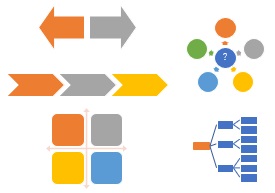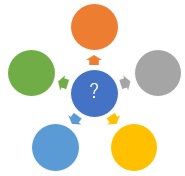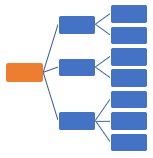
Fortunately, in various fields, our predecessors have prepared lists of items. Not only is this convenient for you, but it also has the advantage of making it easier for others to check.
These lists and their representations are called "frameworks" and are often introduced in books written by people in the consulting field.
There are various frameworks, but some of them are designed to be considered as MECE. On this page, I've organized these frameworks in terms of "binomials" and "dimensions", as is common in Data Science . By arranging things in this way, it becomes easier to understand that there are various types of "MECE", and it seems to be easier to think of new frameworks.

The binomial MECE is a simple case of the interval MECE Because it is simple, there is an advantage that is easy to think about.

Make it logically MECE. There is an example on the MECE analysis page.
See which one of the opposite properties.
It's similar to plus and minus, but it's a way of looking at things that are hard to see along with things that are easy to see.
Divide things according to their relationship.
This is the basis for thinking about the system .
One-dimensional MECE is to make 2-term MECE into 3 or more terms. There is a point of view of one item (one dimension), the axis of the variable is divided to create an interval, the interval is named, and it is a method to think without omission.

4P is a point of view when considering sales promotion. It stands for Product, Price, Promotion, and Place.
The one dimension, the order in which products must be delivered to the customer, is divided into intervals.
There is a two-item (two-dimensional) point of view, the axis of the variable is divided to create an interval, and the interval is named, and it is a method to think without exception.
In the case of two dimensions, a framework is known in which each dimension is a binomial MECE, and four areas (4 quadrants) of 2 * 2 are considered.
There is also a method of grouping after placing the items on a two-dimensional plane without setting the interval.

It is used for grasping the current situation of the business. It stands for Strength, Weakness, Opportunity, and Threat.
The four items use the two dimensions of "environment (internal and external)" and "surface (positive and negative)" to divide the area into four areas.
3C is a point when analyzing the current situation of the company. It stands for Customer (market/customer), Competitor (competitor), and Company (our company).
There are two dimensions: the dimension divided into sellers and buyers, and the dimension divided into the company and competitors. On the buyer side, the same person can be the buyer for both you and your competitors, so instead of four realms, there are three.
The method of looking at things multidimensionally from various perspectives is called multidimensional MECE here.
In the case of multi-dimensional MECE, the MECE idea is to look at things from multiple perspectives, rather than using where you are in space.
The items that appear in the multidimensional MECE are different in terms of viewpoint, but their contents are mutually related. Therefore, the same thing can be viewed and explained from different points of view, and in that sense it overlaps, so it may not be strictly MECE, but at least it makes it difficult to lose important ideas.

It stands for When, When, Who, What, Why, How.
In addition, when examining the current situation from the viewpoint of why, it will be mixed with factor analysis and cause confusion. In understanding the current situation, it is better to remove Why and use 4W1H.
5M1E is often explained as a way to create a Fishbone diagram (Cause-and-Effect Diagram) . It stands for Man, Machine, Material, Method, Measurement, and Environment.
There are also 5M without E and 4M without Measurement.
QCD is used from the perspective of "Where will the effect be achieved when making improvements?" It will also be a point when thinking about the function of the company.
In factories, E (Environment) and S (Safety) are sometimes added to make it "QCDES."
Functional MECE is the functional aspect of a system. Looking from the side of the element is the element MECE.
Like people in a company or machine parts, functions and elements are often linked, so it seems that the results are often the same regardless of whether they are considered from the perspective of function or element, but they are not always the same. I have.

General Affairs, Legal Affairs, Manufacturing, Design, Logistics, Purchasing, etc.
NEXT 

 Quantity Way of Making Hypothesis
Quantity Way of Making Hypothesis
